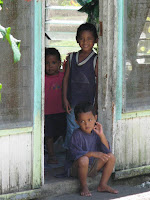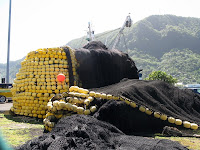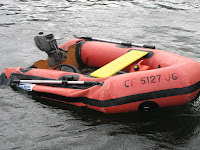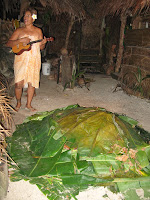
We made landfall in American Samoa with bluster and fanfare. The first few days of our passage were a real snooze, with trade winds eerily absent, asleep on the job. But we stole a joy ride for the remainder, finally exceeding the elusive 200-mile day with gusto, logging 221 miles in a 24-hour period. For you land-lubbers, this sounds pretty paltry. For you mariners, you can imagine the thrill, averaging 9.2 knots. Ben hogged the helm overnight, which was fine by me. Our timing was off for a visit to Suwarrow, as we would have entered the pass at nightfall on the crest of heaving swell.

So, we continued along the rhumb-line to Pago Pago harbor on the island of Tutuila, the largest of American Samoa’s three islands. We thought we might try to slow down to ensure a daylight arrival but the squalls would have none of it. With rain and wind overtaking us every 20 minutes, and with reduced sail, the island was looming in a hurry. So, time to navigate; we don’t have brakes. We skirted the edge of a reef and found our lighted sightings (at least the ones that were working), with wind and waves propelling us toward the lee shore. As I was on the helm I was the first to notice a change in our speed, right as we were passing through the narrow channel between the reef and the island. With a little investigation we found we had had a 1-1/4” line and float caught on our keel, impossible to avoid in the dark. Oops. So we backed up, snagged the line and cut it free. But that was wet business since backing into waves invites a fair bit of water into the cockpit. Finally we wended our way into the harbor’s entrance, luckily long, angled and protected from the surging swell. Then, midnight, time to drop anchor. This we had heard to be a fair challenge as Pago Pago harbor is a commercial port known for poor holding and an obstacle course of garbage to contend with. We got lucky on our first go but were chased off by another cruiser who was convinced our anchor would drag in his direction. We didn’t agree but, tant pis, we moved to keep the peace. This proved to be more of a challenge, as I detached our anchor from plastic bags and a chunk of rug, but finally we were settled.

Two things about Pago Pago jump out. First, it’s surrounded by mountains, verdant with tropical growth, really a beautiful backdrop to this protected harbor. Second, but first to assault the senses, is the odor. Starkist and Chicken of the Sea operate their canneries here. They seem to be improving their practices (now separating fish oils out of their effluent to use as biofuel, thus powering the plants), but they reek, and the smell permeates all. It keeps you fully aware of the wind’s direction; a minor shift alters one’s olfactory experience profoundly. The canneries have been packing tuna for 60 years, providing a slew of jobs and drawing Western Samoans (the independent nation next door) here for work. There is a constant line-up of tuna clippers, awaiting their turn to drop their load and head back out to sea for another 80-day stint. This is serious business; each load of fish figures in the millions. Some boats come equipped with a helicopter used to scout out schools of tuna. The tuna don’t stand a chance. Interestingly, NOAA has a field office here and there is a NOAA observer assigned to every boat to monitor by-catch and fishing procedures on these ships.

Another thing stands out about American Samoa. Well, it’s America. Samoan is the native language but everyone speaks English here as well, and currency is paid in American dollars. This is also the first “territory” we’ve encountered in which the inhabitants adore their empire. There seems to be a basic recognition that this island economy couldn’t make it on its own and they’re pleased to be subsidized, and yet left to govern as they choose. Each year a contingent of Samoan chiefs makes their way to Congress, dressed in traditional regalia, to make their budgetary requests. Apparently this event is relished by our Congressmen and the budget is routinely approved. What that funding means here in American Samoa, for example, is a 10-dollar membership to receive full, life-time medical coverage. It’s not a free ride, though, as many Samoans are currently fighting in Iraq, and yellow ribbons abound. We met an American guy, married to a Samoan, who relocated here after his wife delivered a baby 3 months premature. They couldn’t afford the $3000/month premiums for a premie back home so they sought out medical care here. So far, so good. So, I guess it is America, and yet not America.
The other common thread? Football. Everyone knows the Samoans are big-boned and heavy-set. This makes them ideal linemen. Walking down the street Ben saw a young guy wearing a jersey numbered 51. “Lofa Tatupu!” Ben yelled. (A Seattle Seahawk, and middle linebacker, in case you’re not up on the NFL). The kid yelled back, “That’s my brother!”

We met up with Wayne from Moonduster, the cruiser we had first met back in Ensenada Mexico. We got the introduction to Pago Pago from Wayne, caught up on our various travels, and cooked some fabulous meals. We shared a rental car and took a tour of the island, finding the scenery increasingly pastoral and pristine shortly after leaving town and its environs. Along the road the approach to each village is gaily painted and adorned with colorful coconuts, along with Samoan and English words of welcome – Talofa! Each village has at least one church, and these are usually pretty grandiose affairs. Along the road each family builds an open-air, roofed structure supported by pillars constructed for funerals, weddings and family celebrations – a “Samoan House,” it’s called. We saw a gathering of formally dressed Samoans as we entered one village and decided to check it out. One man, holding a staff, stood surrounded by gifts, addressing another staff-holding man, just opposite, also surrounded by gifts. We learned that these were two chiefs, and this was a ceremony and celebration, as one village was “giving” their church’s reverend to this village’s church. All age groups were present and it seemed a happy occasion. The villagers made us welcome and were happy to explain the proceedings. We marveled at their flower-adorned roast pigs and traditional costumes, and were never made to feel intruders. In the end we were sent on our way with gifts of food and drink.

Other noteworthy anthropological points of interest: Public service announcements grace every billboard in town and beyond, warning of teenage pregnancy, drunk driving, domestic abuse; encouraging seat-belts and vaccination. Elections are taken seriously and campaign signs cover any stationary surface. Men (even too cool teens) wear lavalavas (sarongs for men). Locals spend a good deal of their free time in the water – it’s certainly a well-used natural resource. Interestingly, they swim fully clothed.

A couple forces have converged to keep us in American Samoa longer than we had planned. What’s new, right? We had arranged for a new membrane (for our watermaker) to be sent to American Samoa. It arrived, alright, but FedEx failed to hold the package for us and it had already been sent back to the States before our arrival. Glitch number one. Furthermore, our dinghy, the ever-abhorred and much abused, sputtered its last, whistling gasp, giving us the ‘ol raspberry on its way out. After some scrambling we convinced a fellow cruiser to sell us his. It’s smaller, and promises a wet ride, but who’s complaining; it beats the doggie paddle. So, one week became two, and here we are in Pago Pago.

In the meantime we’ve been meeting other cruisers, a jumble of Canadians, South Africans, Brits and Americans, for the most part. You see, Pago Pago gets a bad rap with its commercial harbor, so American Samoa if off the tourist-beaten path. There really aren’t any hotels or resorts here to speak of. But the island is lovely and the people go out of their way to be helpful; most cruisers don’t know what they’re missing. We took an outing with some friends we’d made, en masse, to the Barefoot Bar on the beach. The owner (a woman named Tisa and chief of her village) prepared a traditional Samoan meal, meats cooked on hot rocks placed in a hole in the sand -- an Umu, in Samoan. This is covered with banana leaves and left to cook through the day. We feasted on pork, chicken, turkey, octopus, seafood (cooked in coconut cups), as well as roasted breadfruit, taro, papaya and bananas. A feast indeed.
The outlook for our departure? Monday or Tuesday (Aug 25th or so) is the day. We’ll attempt to scrub our anchor chain free of gobbledygook and whatever mutant creatures breed in this murky brew but I’m afraid we’ll be trailing Pago Pago’s odor along with us for the ride. From here we’ll be making a two-day hop, skip and jump to Vava’u, the northern island group in the Kingdom of Tonga. More as it happens.
